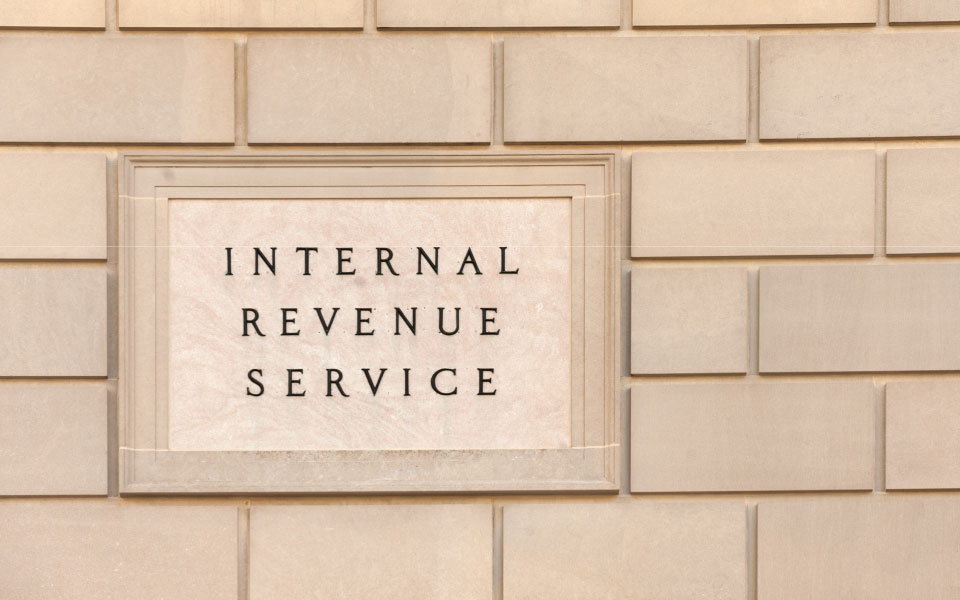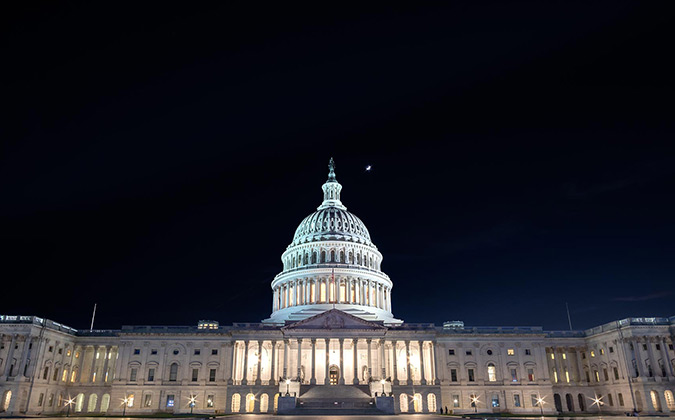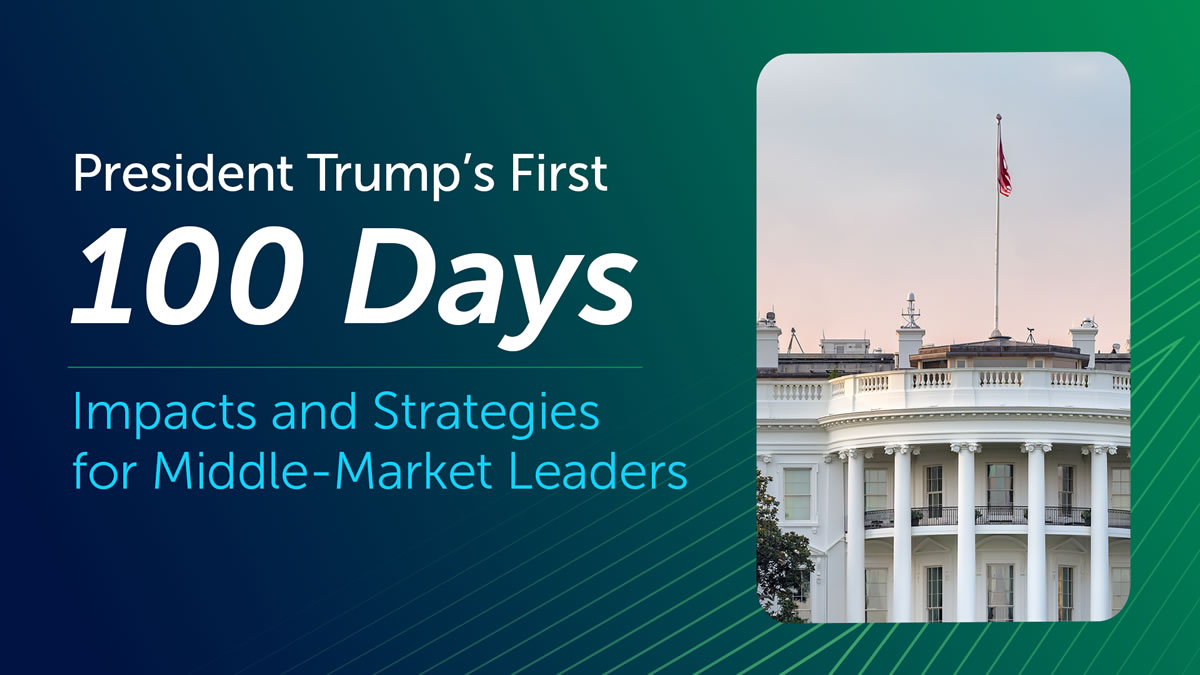CBIZ advisors across tax, advisory, benefits, and insurance are fielding one recurring question: What now?
In just 100 days, executive action has reshaped the middle-market landscape. Reinstated and new tariffs, sweeping federal cuts, and a leaner IRS signal a return to policy volatility. But with disruption comes opportunity—for those ready to lead with agility.
This guide dives into what’s changed, what’s at stake, and the smart steps your business can take before headlines turn into headaches.
At a Glance: What’s Changed So Far
In a sweeping move, the IRS announced plans to cut up to 20,000 employees — nearly 25% of its workforce, as reported by the Associated Press. The impact has been destabilizing, leading to reduced capacity.
Why It Matters
The shrinking IRS workforce is resulting in refund delays, audit backlogs, and increased risk of fraud, all of which create complications for employers.
President Trump signed an executive order ending the $800 import threshold removed for goods from China, introducing immediate duty costs on previously exempt shipments.
Why It Matters
E-commerce and consumer brands face higher sourcing costs for items, including electronics and apparel.
Middle-market companies must re-examine their pricing strategies to remain competitive. Here are a few initial questions to think about:
- How can automation help your business efficiently calculate duties and taxes while ensuring compliance with stricter regulatory requirements?
- Are you taking advantage of all available tax credits and incentives?
- Can you shift your supply chain structure to domestic suppliers or countries with more favorable trade conditions?
- Do your inventory and accounting systems accurately reflect your qualifying thresholds?
- Should you consolidate shipments?
Steel, aluminum, and other imports from key trade partners face new duties.
Why It Matters
Cost spikes across manufacturing, construction, and retail.
FinCEN exempts U.S.-formed entities from ownership disclosures.
Why It Matters
Foreign filers face tight compliance timelines.
Uncertainty stalls private equity deals and cross-border activity.
Why It Matters
Capital is sidelined until market clarity returns.
Attempts are in motion to extend the soon-expiring Tax Cuts and Jobs Act of 2017 (TCJA) and expand tax cuts. The budget reconciliation process has begun, and new legislation will be developed over the coming months.
Why It Matters
Tax cuts could boost employers’ bottom line but may have significant consequences for the U.S. economy and federal budget.
Trade & Tariffs: Cost Shock Meets Strategic Opportunity
Tariffs are challenging established procurement, pricing, and tax planning strategies.

Our Integrated Tariff Solution
CBIZ applies integrated thinking across pricing, tax, supply chain, and financial modeling to help clients unlock cost savings, mitigate risk, and build more resilient operations.
- Assess Impact: Tariff exposure assessments quantify financial, pricing, and operational implications.
- Mitigate & Optimize: Duty drawbacks, bonded warehousing, reshoring strategies, and transfer pricing adjustments help reduce liability and increase resilience.
- Implement & Monitor: Dynamic financial models support real-time decision-making, ongoing compliance, and forward-looking risk management.
Tariffs: Financial and Tax Priorities
In light of recent tariff actions, CFOs and controllers must navigate complex accounting challenges, ranging from inventory valuation adjustments to tax compliance, which require a strategic recalibration of financial processes.
Inventory Valuation Adjustments
Challenge
Tariffs can affect gross margins and cost of goods sold.
Response
Finance teams must review enterprise resource planning (ERP) configurations to ensure tariff costs are added to inventory valuations. A misstep here could understate inventory and distort profitability.
Learn More About ERP Configurations
Asset Impairment & Margin Pressure
Challenge
Increased tariff costs can trigger impairments of long-lived assets and cause margin compression.
Response
Incorporate robust impairment tests into financial models.
Pressure-Test Asset Value Amid Uncertainty
Financial Disclosures & Systems
Challenge
Transparent disclosures about tariff impacts and system upgrades for real-time landed cost tracking are imminent.
Response
Ensure internal systems, including ERP, can seamlessly integrate tariff data to support accurate financial reporting.
Revenue & Pricing Implications
Challenge
Tariffs can alter revenue recognition by creating ambiguities on whether extra charges are passed to customers or expensed.
Response
Reassess pricing models to differentiate between pass-through costs and core revenue enhancements.
Get FAAS Support for Accurate Reporting
Tax Provision & Transfer Pricing Effects
Challenge
Tariff-induced cost shifts can change deferred tax positions and necessitate a review of intercompany pricing policies.
Response
Update tax forecast models to reflect changed inventory and COGS dynamics.
Optimize Transfer Pricing for Trade Shifts
Technology: High Demand, Low Supply
Challenge
There will be waves of price increases by many entities, like Dell, to offset the cost of the tariffs.
Response
Businesses should act quickly to purchase hardware and optimize inventory planning to save costs and avoid delays.
Strategic Clarity
Navigate cost shifts and margin pressures with CBIZ’s end-to-end tariff strategy and financial modeling support.
Tax Policy & Compliance: Uncertainty, Delays, & Audit Signals

IRS Layoffs Disrupt Filing Season
Response: Plan for refund delays, irregular enforcement.

Audit Risk Is Down — Not Gone
Response: Bolster documentation, avoid red flags.

Tariff-Driven Tax Adjustments
Response: Update tax models to capture changes.

BOI Reporting Rule Narrowed
Response: Ensure foreign entities meet deadlines.

Potential Changes to Executive Compensation Taxation
Response: Prepare to reevaluate your executive compensation strategy.
TCJA Temperature Check
- President Trump has prioritized permanently extending the provisions of the Tax Cuts and Jobs Act (TCJA).
- Congress is debating whether to renew or make the provisions permanent as part of budget reconciliation.
- Major implications for entity structure, compensation strategies, and tax forecasting.
- Congressional committees will craft legislation that adheres to the instructions in the budget resolution, aiming to send a completed bill to the president by Memorial Day.
- Legislation includes allocating funding for border and immigration resources, as well as defense initiatives.
- Adjustments to the $10K SALT deduction cap are also being considered.
- The scale of the budget package could trigger trade-offs in other areas, potentially impacting enforcement efforts and program funding.
Response
Model multiple tax reform scenarios tailored to your business; prepare to adjust mid-cycle based on final legislative outcome.

Regulatory & Workforce Shifts: From Oversight to Uncertainty
Immigration enforcement is becoming more stringent, with a focus on stricter employer compliance and expanded control measures. This heightened focus may lead to an increase in I-9 audits and potential disruptions within the workforce.
Response
Conduct internal I-9 audits*, streamline processes with an HRIS to automate information capture and documentation, assign a dedicated point of contact, and establish clear protocols to prepare for potential ICE workplace raids.
*Note that USCIS released the updated Form I-9 on April 2, 2025, but employers may continue to use previous editions until their respective expiration dates.
Efforts to expand E-Verify, a system used by around 1.3 million U.S. employers, have begun but are facing slow adoption on a national scale.
Response
To prepare for potential expansion, consider integrating E-Verify with your HRIS platform. This integration can simplify and streamline the process of verifying employee work eligibility.
Amid reduced audit activity at the federal level, states are increasingly auditing employers to ensure compliance with wage and hour laws, benefit funding obligations, paid leave requirements, and more.
Response
Maintain comprehensive documentation on employee benefits, wage and hour compliance, and state-specific mandates like paid family leave, retirement plan contributions, and DEI disclosures.
In December 2024, the court reversed changes made to the Fair Labor Standards Act. With the change of administration, this and other laws may be revisited.
Response
Amid regulatory limbo, prepare for potential policy reversals and ongoing uncertainty by thoroughly documenting employee classifications, exemption determinations, and wage policies.
The ACA is under scrutiny and may be hit with targeted reforms, such as reporting requirement rollbacks, employer mandate eliminations, or loosened essential health benefits standards. Price transparency rules are also being revisited. While this may create compliance challenges, it may also open benefits-related opportunities.
Response
Reassess benefits packages to ensure compliance and explore self-funded or level-funded plans amid increased plan flexibility.
Increased regulatory scrutiny could lead to higher liability and potential enforcement actions in areas like corporate governance, financial reporting, and employment practices.
Response
As oversight continues to scale back across federal agencies, the burden of risk management will shift more heavily to businesses. To protect your organization from emerging gaps in enforcement and liability exposure, consider these best practices:
- Audit workplace safety programs, training protocols, and compliance procedures.
- Update employee handbooks, procedures, and HR policies to align with current regulations.
- Strengthen internal financial controls and reporting oversight.
- Reinforce cybersecurity protocols, employee awareness training, and response plans.
- Review and validate your insurance coverage for emerging gaps.
- Confirm proper employee classifications and payroll practices.
- Maintain detailed documentation of safety, compliance, and financial decisions.
With fewer federal guardrails, the burden of workplace risk management falls squarely on employers. Businesses face greater exposure to legal challenges, employee claims, and operational risks, potentially impacting operational efficiency and your bottom line.
Response
Tighten internal safety protocols and HR policies. Reinforce EPL and workers’ comp coverage and partner with risk advisors to fill compliance gaps.
Trump’s “America First Investment Policy” calls to prohibit retirement plan investments in foreign adversary and sanctioned entities. While there’s no guidance on how countries may be defined as such, it may be important for plan sponsors to monitor their plan’s investments.
Response
Determine if your plan has any investments in these entities and prepare to adjust as needed.
Delays continue and uncertainty remains as to the future of the fiduciary rule.
Response
Stay informed to ensure compliance with the latest regulations.
Increased tariff complexity brings new challenges to internal controls.
Response
Businesses must revisit internal controls and upgrade IT systems to capture real-time landed cost data. This proactive step helps mitigate risks and streamline the compliance processes.
Industry Impacts & Strategic Responses
President Trump’s first 100 days have created ripple effects across nearly every industry. From aggressive tariff policy and executive orders to evolving immigration rules, R&D tax reform, and regulatory shifts, the middle-market is navigating a transformed operating environment.
Each industry is responding to these changes in distinct ways — adjusting sourcing strategies, rethinking workforce planning, reshaping capital investment, and preparing for new risks. Below, we explore key sectors affected by recent policy moves and outline early steps companies can take to mitigate disruption and position for growth.
Once seen as a primary beneficiary of reshoring and industrial stimulus, the manufacturing sector now faces headwinds in the form of rising input costs, import tariffs, and supply chain disruptions. Margins are tightening — and fast action is needed.
The construction industry has been navigating rising materials costs for years, but new steel and aluminum tariffs, coupled with labor pressures and immigration shifts, have added new complexity to project planning and cost forecasting.
Retailers and consumer brands are especially exposed to tariff volatility, as they rely heavily on imports from China, Vietnam, and other countries. Tariff increases can squeeze profit margins and force elevated consumer prices, potentially weakening market competitiveness.
Tariffs disrupt supply chains, forcing companies to find alternative suppliers, often leading to higher costs and increased operational risk. Additionally, ongoing uncertainty may dampen consumer confidence and spending, making long-term strategic planning even more challenging.
Supply chain shocks and ingredient tariffs are creating ripple effects throughout the food and beverage sector. As consumers continue to prioritize wellness and sustainability, companies must juggle cost control with innovation.
The tech industry is grappling with dual pressures: rising component costs and immigration policy changes that threaten talent pipelines. Meanwhile, potential changes to R&D tax treatment have added a layer of planning urgency.
Life sciences is a sector built on global collaboration and specialized supply chains, and is especially vulnerable to geopolitical and regulatory shocks. Trial timelines, innovation investments, and public funding access all hang in the balance.
The digital assets space is experiencing a regulatory pivot — from adversarial enforcement to active integration into national strategy. Firms must remain agile as new frameworks and obligations emerge.
The real estate sector is navigating rising construction costs, access-to-capital challenges, and regulatory shakeups that influence development, leasing, and investment decisions.
For private equity firms, 2025 has not delivered the clarity many expected. Instead, deal flow has slowed as firms wrestle with volatility in tariffs, interest rates, and regulatory policy. The opportunity now lies in shifting from prediction to precision.
Manufacturing
Once seen as a primary beneficiary of reshoring and industrial stimulus, the manufacturing sector now faces headwinds in the form of rising input costs, import tariffs, and supply chain disruptions. Margins are tightening — and fast action is needed.
Explore Our Sector-Specific Solutions
Challenge
Input cost spikes, limited cost pass-through, and capital constraints on supply chain shifts.
Response
- Source alternative suppliers in tariff-exempt regions to reduce exposure.
- Apply for duty drawbacks and explore bonded warehousing options.
- Consider strategic reshoring of operations to qualify for federal and state incentives.
- Reevaluate transfer pricing and customs valuation methods to optimize declared import costs.
- Review inventory methodologies — such as LIFO vs. standard costing — and assess implications for asset impairment disclosures.
Construction
The construction industry has been navigating rising materials costs for years, but new steel and aluminum tariffs, coupled with labor pressures and immigration shifts, have added new complexity to project planning and cost forecasting.
Watch Our Webinar: Mitigating Risks & Ensuring Success in Construction Projects
Challenge
Tariffs on metals raise material costs; labor shortages intensify due to immigration constraints.
Response
- Secure long-term pricing contracts to hedge against cost fluctuations.
- Build flexible financial models to evaluate sourcing alternatives and margin compression.
- Consider alternative building materials and modular construction approaches.
- Reassess workforce strategy in light of shifting immigration policy and local talent shortages.
Consumer & Industrial Products
Retailers and consumer brands are especially exposed to tariff volatility, as they rely heavily on imports from China, Vietnam, and other countries. Tariff increases can squeeze profit margins and force elevated consumer prices, potentially weakening market competitiveness.
Tariffs disrupt supply chains, forcing companies to find alternative suppliers, often leading to higher costs and increased operational risk. Additionally, ongoing uncertainty may dampen consumer confidence and spending, making long-term strategic planning even more challenging.
Partner With Our Consumer & Industrial Products Team
Challenge
Tariffs on Chinese imports compress margins in an inflation-sensitive market.
Response
- Adjust transfer pricing and product classification to reduce effective duty rates.
- Rebalance sourcing toward regions with more favorable trade agreements.
- Introduce dynamic pricing models to manage consumer perception and protect brand equity.
- Improve inventory visibility to reduce overstock and obsolescence amid longer lead times.
Food & Beverage
Supply chain shocks and ingredient tariffs are creating ripple effects throughout the food and beverage sector. As consumers continue to prioritize wellness and sustainability, companies must juggle cost control with innovation.
See How CBIZ Supports F&B Clients
Challenge
Ingredient tariffs inflate COGS; tariff volatility adds pressure to innovate quickly.
Response
- Prioritize sourcing from U.S. producers and leverage federal/state agriculture incentives.
- Use SKU-level margin tracking to drive pricing strategy and promotional planning.
- Diversify product lines with locally sourced or trend-forward ingredients.
- Mitigate volatility by forward contracting and engaging with food supply coalitions.
Technology
The tech industry is grappling with dual pressures: rising component costs and immigration policy changes that threaten talent pipelines. Meanwhile, potential changes to R&D tax treatment have added a layer of planning urgency.
Explore Our Technology Industry Services
Challenge
Tariffs on components, supply chain delays, and tightening immigration policies strain innovation cycles.
Response
- Leverage bonded warehouses and just-in-time supply chain practices to defer costs.
- Use predictive analytics to forecast disruptions and respond to pricing shifts in real time.
- Align tax planning with inventory strategy and monitor implications of potential R&D tax changes.
- Strengthen workforce planning in light of immigration reform and international talent access.
Life Sciences
Life sciences is a sector built on global collaboration and specialized supply chains, and is especially vulnerable to geopolitical and regulatory shocks. Trial timelines, innovation investments, and public funding access all hang in the balance.
Discover CBIZ's Life Sciences Practice
Challenge
Trial delays, higher input costs, disrupted supply chains, and reduced access to government funding.
Response
- Revalidate suppliers and diversify sourcing for critical reagents and lab equipment.
- Adjust financial forecasting to accommodate longer clinical timelines and grant variability.
- Monitor shifts in FDA approval frameworks to anticipate regulatory risk.
- Explore alternative R&D funding strategies, including private partnerships and offshore trials.
Digital Assets & Blockchain
The digital assets space is experiencing a regulatory pivot — from adversarial enforcement to active integration into national strategy. Firms must remain agile as new frameworks and obligations emerge.
Visit the CBIZ Digital Assets & Blockchain Hub
Challenge
Regulatory volatility and fragmented enforcement across federal agencies.
Response
- Monitor Executive Orders and agency statements to guide strategic compliance.
- Align tax planning with changes to custodial obligations (SAB 122) and digital asset reserve policy.
- Prepare for shifts in reporting standards, with full retrospective treatment where applicable.
- Leverage evolving federal clarity as an opportunity to build trust and institutional adoption.
Real Estate
The real estate sector is navigating rising construction costs, access-to-capital challenges, and regulatory shakeups that influence development, leasing, and investment decisions.
Explore CBIZ Real Estate Services
Challenge
Tariffs and inflation increase project costs, while economic uncertainty tempers leasing demand.
Response
- Reevaluate build-to-suit project timelines in light of rising steel and construction costs.
- Model tax changes, incentives, and inflation risks into long-term pro forma assumptions.
- Strengthen ESG positioning and reevaluate asset classes (e.g., logistics vs. retail) to align with market trends.
- Stay proactive with zoning, permitting, and incentive negotiations in key markets.
- Monitor interest rate trends to capitalize on future rate reductions, improving overall project cost structures and financing flexibility.
Private Equity
For private equity firms, 2025 has not delivered the clarity many expected. Instead, deal flow has slowed as firms wrestle with volatility in tariffs, interest rates, and regulatory policy. The opportunity now lies in shifting from prediction to precision.
Learn More About How CBIZ Supports Private Equity
Challenge
M&A slowdowns, tariff exposure, and strained forecasts in portfolio companies.
Response
- Shift from traditional forecasting to cash-centric planning and operational scenario testing.
- Focus on organic value creation through margin improvement, pricing optimization, and automation.
- Model tariff impact across the supply chain and explore cost pass-through in pricing strategies.
- Double down on sector diversification, AI integration, and executive leadership development.
The Middle-Market Playbook
-
Integrate Tax, Trade, & Supply Chain Planning
Align cost, risk, and pricing strategy under one roof. Explore the CBIZ Tariff Response Framework.
-
Review & Update Tariff Accounting & Pricing Systems
Consider revising contract clauses and customer agreements to allow for flexibility in cost pass-through. Strengthen Tariff Strategies With CBIZ Support.
-
Rethink Pricing & Product Strategy
Tighten SKUs and apply value-based messaging. Find Industry-specific Strategies and Support.
-
Tighten Compliance Readiness
Review documentation, BOI status, and IRS-sensitive positions. Learn More: Here’s How to Avoid an Audit.
-
Scenario Plan for Tax Reform
Use models to test TCJA outcomes. Discuss Tax Planning With CBIZ Today.
-
Invest in Automation Where It Counts
Offset wage and sourcing volatility with digital tools. Your Automation Roadmap Starts Here.

-
Reevaluate Your Risk Landscape
Identify where your business could be newly exposed. Learn More: Get the Steps to Conduct a Business Risk Assessment
-
Optimize Your Insurance Coverage
Update policies to reflect emerging risks and liabilities under new regulations. Navigate Employment Practices Liability Insurance With Our Latest Insight.
-
Assess Your Retirement Program
Evaluate your retirement program to ensure compliance with the latest regulations. Get Support to Maintain an Effective and Competitive Retirement Plan.
-
Prepare for Heightened Immigration Enforcement
Review hiring procedures and I-9 compliance to mitigate risks. Prepare for ICE Audits Today.
-
Get I-9 & E-Verify Ready
Strengthen verification processes and protocols to stay ahead. Ensure Form I-9 Compliance With This Checklist.
-
Optimize Your Benefits Plan Strategy
Go beyond reevaluating your plan to developing a total rewards program. Use This Guide to Build a Winning Total Rewards Program.
-
Monitor State-Level Mandates
Track evolving wage, leave, and retirement laws as states ramp up audit activity. Bookmark Benefits Beat for the Latest Regulatory and Legislative Updates.

What’s Ahead
Keep going: Use the arrows to check out everything we’re tracking for what’s next.
Let’s Talk Strategy: The CBIZ Advantage
You’ve seen the headlines — and the impact. Tariffs, tax changes, workforce challenges, and regulatory uncertainty are converging fast. But with the right strategy, these aren’t just challenges. They’re leverage points.
CBIZ works with middle-market businesses to connect the dots between global disruption and operational decisions. From tariff response and tax planning to workforce solutions and compliance readiness, we help you act early and act with impact.
Ready to turn disruption into direction?
- Start with a customized impact assessment.
- See how other companies have saved millions.
- Build a roadmap for resilience.
Use our quick intake form to tell us your top concern — tariffs, tax strategy, supply chain, workforce issues, compliance, or a combination — and we’ll connect you with the right CBIZ advisor for your industry and business size.
Investment advisory services provided through CBIZ Investment Advisory Services, LLC, a registered investment adviser and a wholly owned subsidiary of CBIZ, Inc.
Third party administration, actuarial, and other consulting services offered through CBIZ Benefits & Insurance Services, Inc.

